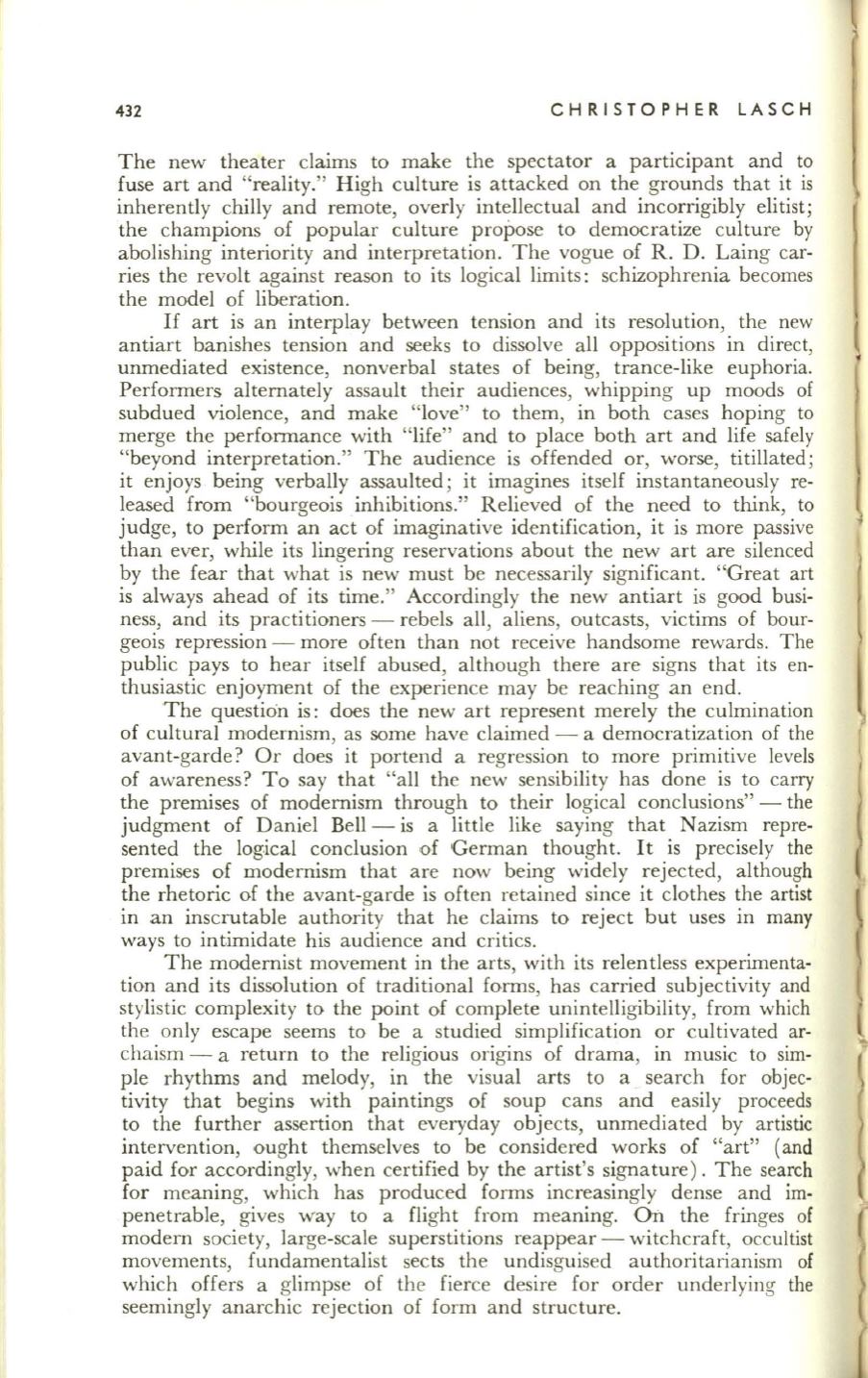
432
CHRISTOPHER LASCH
The new theater claims to make the spectator a participant and to
fuse art and "reality." High culture is attacked on the grounds that it is
inherently chilly and remote, overly intellectual and incorrigibly elitist;
the champions oJ popular culture propose to democratize culture by
abolishing interiority and interpretation. The vogue of R. D. Laing car–
ries the revolt against reason to its logical limits: schizophrenia becomes
the model of liberation.
If
art is an interplay between tension and its resolution, the new
antiart banishes tension and seeks to dissolve all oppositions in direct,
unmediated existence, nonverbal states of being, trance-like euphoria.
Performers alternately assault their audiences, whipping up moods of
subdued violence, and make "love" to them, in both cases hoping to
merge the performance with "life" and to place both art and life safely
"beyond interpretation." The audience is offended or, worse, titillated;
it enjoys being verbally assaulted; it imagines itself instantaneously re–
leased from "bourgeois inhibitions." Relieved of the need to think, to
judge, to perform an act of imaginative identification, it is more passive
than ever, while its lingering reservations about the new art are silenced
by the fear that what is new must be necessarily significant. "Great art
is always ahead of its time." Accordingly the new antiart is good busi–
ness, and its practitioners - rebels all, aliens, outcasts, victims of bour–
geois repression - more often than not receive handsome rewards. The
public pays to hear itself abused, although there are signs that its en–
thusiastic enjoyment of the experience may be reaching an end.
The question is: does the new art represent merely the culmination
of cultural modernism, as some have claimed - a democratization of the
avant-garde? Or does it portend a regression to more primitive levels
of awareness? To say that "all the new sensibility has done is to carry
the premises of modernism through to their logical conclusions" - the
judgment of Daniel Bell- is a little like saying that Nazism repre–
sented the log.ical conclusion of German thought.
It
is precisely the
premises of modernism that are now being widely rejected, although
the rhetoric of the avant-garde is often retained since it clothes the artist
in an inscrutable authority that he claims to reject but uses in many
ways to intimidate his audience and critics.
The modernist movement in the arts, with its relentless experimenta–
tion and its dissolution of traditional forms, has carried subjectivity and
stylistic complexity to the point of complete unintelligibility, from which
the only escape seems to be a studied simplification or cultivated ar–
chaism - a return to the religious origins of drama, in music to sim–
ple rhythms and melody, in the visual arts to a search for objec–
tivity that begins with paintings of soup cans and easily proceeds
to the further assertion that everyday objects, unmediated by artistic
intervention, ought themselves to be considered works of "art" (and
paid for accordingly, when certified by the artist's signature). The search
for meaning, which has produced forms increasingly dense and im–
penetrable, gives way to a flight from meaning.
On
the fringes of
modern society, large-scale superstitions reappear - witchcraft, occultist
movements, fundamentalist sects the undisguised authoritarianism of
which offers a glimpse of the fierce desire for order underlying the
seemingly anarchic rejection of form and structure.


